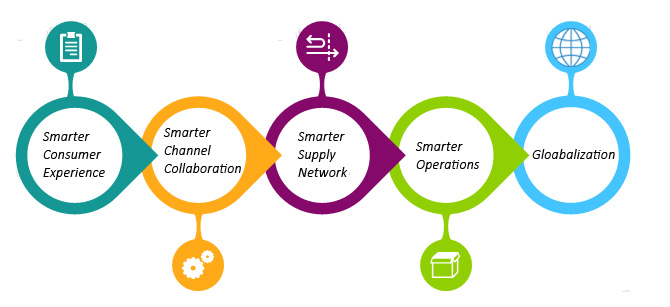Consumer Goods
The consumer goods industry is witnessing an overhaul with rapidly changing consumer behaviour. Consumer tastes, preferences, and needs are evolving with changing global affairs like the pandemic.
The competition in the consumer products industry is for shelf space; therefore firms strive to have a sophisticated package design, involving marketing, and satisfying customers. The challenges faced in the consumer products sector include; addressing the changing demands of customers, going through the consolidation market, and execution of strategies that are significant to profitable growth.
What are the Consumer Products Value Chain?
Optimized inbound:
It is the first segment in the consumer products industry value chain that streamlines sourcing, movement of goods from the point of manufacture, packaging, and accessories.
Sourcing and procurement:
Firms in the consumer products industry should consider procuring raw materials that are of high standard and quality to produce quality end products that satisfy their customers.
Product development and manufacturing:
Involves implementing a strategical product development process and manufacturing to design new products, improve existing products that satisfy their customers, and have the chance of entering new markets and selling to more customers.
Marketing and Sales:
Involves all the activities that sell the company’s products and services through advertising and determining the best methods to reach customers through creation of marketing campaigns, and confirming relationships with customers through sales campaign.
Human resources:
This segment of the value chain involves effective management of employees consisting of employee compensation and benefits that enable them to work effectively and contribute to the firm having solid returns from its investments.
Returns management:
It is the stage that deals with consumers and manages expectations from customers in an effort of improving overall customer experience as well as ensuring recovering from values from returns.
Value recovery:
The stage deals with the protection of the company’s brands by increasing recovery of returned products through the use of environmentally responsible solutions.
Management of aftersales:
The step provides companies in the consumer products sector with relevant information they need in understanding the reverse supply chain process and identifying the reasons why some of their products are being returned and also know how they can improve the way their products perform in the market.
Supply networks:
The primary objective of supply networks is to ensure fulfilment of customer demands through having a well-designed distribution pattern, a balanced transportation method used and optimization of the supply network and manufacturer.
Digitization:
It involves aligning technology in the manufacturing process with an aim of creating and optimizing customer engagement and influencing consumer’s path to purchase.
What are the Competitive Advantages in the Consumer Products Industry?

Smarter consumer experience:
In increasing the consumer experience, a company in the consumer products sector should understand the value in retaining customers and be able to generate real-time insights. The company should also think of business science as a way of identifying the programs and strategy that make their customers feel smart as well as satisfy their customers.
Smarter channel collaboration:
The channel collaboration is vital in making your company highly attractive in front of your sales partners. Sales partners in the consumer products sector include wholesale distributors, retailers, and raw material suppliers. Through excellent channel collaboration, the consumer products companies can execute their business functions effectively.
Smarter supply networks:
It marks the future of attaining growth in the consumer products industry. Intelligent supply networks enable CP companies to expand across the globe in finding excellent suppliers as well as reaching out to markets that drive both profit and sales.
Smarter operations:
Companies in the consumer products industry leverage more creative processes through having an agile approach to testing, development, and iterating innovative ideas compared to the old methods used in operations. Smart operations lead to increase in growth and a way of having bolder strategies.
Globalization:
Consumer products companies should strive to have strategical capitalization on growth in emerging markets and seeking the opportunities of having partnerships with other companies to enable them access to customers, integrate new market solutions, and access new sources of raw material acquisition
How Octaware Helps
Working with Octaware Technologies means working with a cross-functional team of experts to help drive value, transform, innovate and grow your consumer goods and services business at scale and pace.
Customer Experience:
Creating unified consumer and customer brand experiences across all channels, enabled by a digitally integrated organization.
Digital Strategy and Transformation :
Helping businesses to transform and evolve quickly to sieze opportunities to cost effectively manage digital commercial experiences and optimize ROI.
Supply Chain Reinvention :
Reinventing the supply chain with agile, profitable, technology-enabled structures to a demand-centric, networked, create-sense-shape-respond one that uses complex supply chain analytics solutions to drive significant improvements.
Harnessing Enterprise Operations to Fuel Growth :
Unlock trapped value with intelligent operations. Create corporate agility and drive business growth with intelligent operating models.
Transform into a data-led insights organization :
Blend human + machine in new ways to harness the power of data and artificial intelligence, powered by cloud, adopted at scale.
Drive Growth through Innovative Business models :
Identify new business growth opportunities and improve performance through consumer goods innovation in products, services, processes and agile business models.